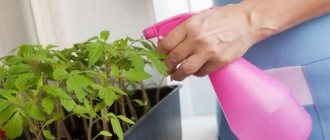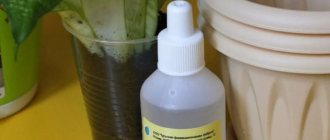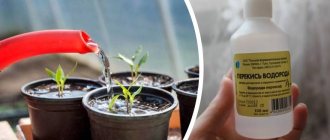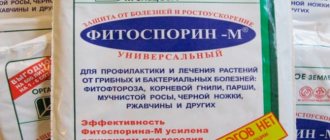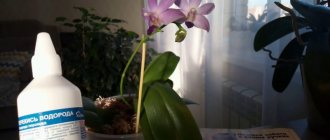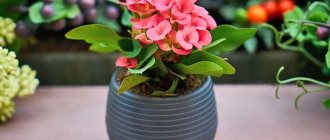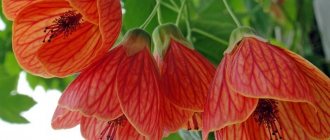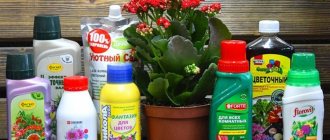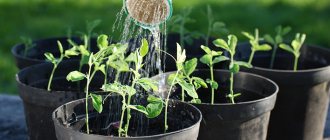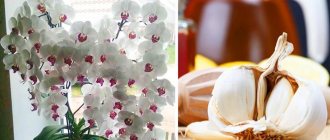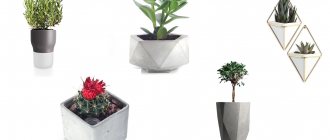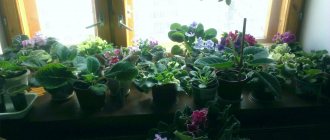Hydrogen peroxide has the chemical formula H2O2. The difference with the water we drink is only one atom of oxygen. Water in nature acquires it due to enrichment with ozone. This happens during a thunderstorm. Because of this natural phenomenon, rainwater is considered beneficial both for people and for various types of plants. After heavy rain, trees, shrubs, grass, and flowers begin to grow vigorously. This is facilitated by oxygen-enriched water. One example is the growth of mushrooms in a matter of hours after rain. In everyday life, a semblance of rainwater with similar properties can be obtained by using hydrogen peroxide as an additive. Treating indoor flowers with hydrogen peroxide is an everyday activity for many gardeners.
Why do indoor plants need hydrogen peroxide?
All housewives use the product as a preventative and for the treatment of certain diseases. Below you can familiarize yourself with the scope of use of hydrogen peroxide for indoor plants.
Why do indoor plants need hydrogen peroxide?
- Prevention of black leg and root rot
- For soil treatment in case of the appearance of fungi, mold and moss
- For soaking seeds to eliminate fungi and viruses
- For the treatment of diseases associated with viruses and fungi
- For processing and disinfecting new soil before replanting plants
- For the treatment of the initial stages of certain ailments and for the purpose of revitalizing plants
Solution
How to feed flowers with hydrogen peroxide?
Peroxide can be used if there are minor disturbances and plants begin to wilt. However, in advanced cases, the remedy may not work.
How to feed flowers with hydrogen peroxide:
- It is best to use living water for watering plants. For this purpose, melted milk is usually used. However, not all housewives have time to freeze and defrost liquid for watering plants.
- Therefore, it can be prepared from tap water. To do this, add a couple of drops of hydrogen peroxide to the liquid.
- Do not store the product for a long time, as oxygen and hydrogen ions disappear very quickly, and the water becomes completely inactive.
Solution
When to use
There are times when the application of this remedy is more necessary than at other times:
- when growing seedlings;
- after picking;
- during the growing season, when shoots and leaves are actively growing;
- during fruiting.
During the dormant period, application is used less frequently, just like regular watering.
Hydrogen peroxide for indoor plants: methods of application
It is recommended to use peroxide during transplantation to treat the roots. As soon as you notice that the plants are starting to wilt, we recommend replanting them in new soil and pot.
Hydrogen peroxide for indoor plants, methods of use:
- You can use the old one, but first wash it with a lot of soda and pour boiling water over it. In addition, an antiseptic can be used to eliminate pathogenic microorganisms that remain on the walls of the vessel.
- Next, you need to thoroughly rinse the roots of the plant, remove damaged areas, black areas, and soak in the solution for 15 minutes. To do this, you will need 20 ml of 3% peroxide per 1000 ml. Only after this is transplantation into a new flowerpot carried out.
- Peroxide contains a large amount of nutritional components and has a good effect on the condition of the soil. Therefore, it is recommended to water once a week with a weak solution. To do this, 15 ml of 3% peroxide is dissolved in 1000 ml. Under no circumstances leave this liquid standing; after just a few hours it loses its properties, as oxygen evaporates and hydrogen along with it. Accordingly, water becomes the most common and does not have universal properties. It becomes absolutely useless for feeding.
- Hydrogen peroxide is widely used to treat bulbous plants. When transplanting to open ground or into a pot, it is necessary to soak the bulbs in the prepared solution for 30-40 minutes. It is necessary to dissolve 10 milliliters of the prepared product in a liter of water and mix. Remember, the solution should be at room temperature or slightly warmed. Be sure to remove all scales, dark spots, and places that have begun to rot from the surface of the bulbs.
Spraying
Hydrogen peroxide for watering indoor plants: benefits
Peroxide does not contain any nutritional components or microelements. However, as mentioned above, hydrogen and oxygen ions are dissolved in it, which improve the quality of the soil.
Hydrogen peroxide for watering indoor plants, benefits:
- That is why it is recommended to use peroxide to enhance the effect of possible fertilizers and minerals. For these purposes, dissolve 10 ml of peroxide solution with a concentration of 3% in 1000 ml.
- The day before feeding the plants with fertilizers or complex substances, it is necessary to water them with a slightly acidic peroxide solution.
- If you haven't thought about it, you can water it the next day. The fact is that oxygen and hydrogen ions enhance the effect of nutritional components, so they are better absorbed.
Treatment
Which form is better
For a home first aid kit, hydrogen peroxide is usually purchased at a concentration of 3%. It can be used for indoor flowers, but if you want to get an excellent effect or if the number and volume of treatments are planned to be considerable, then it is better to purchase this product in a concentration of 35%. The same volume will cost a little more than 3%, but in the end it will last longer, and the result will be more pronounced, that is, in the end this approach is more economical.
It is difficult to find such peroxide in a regular pharmacy, but it is easy to order it on the Internet. In addition, it is often sold not in small bottles, but in 0.5 l or 1 l packaging. In this form, it is actively used on farms. It is especially widely used by American and Canadian farmers.
How to feed geraniums with peroxide?
Geranium is a stunning houseplant that produces beautiful flowers. Peroxide in this case is used to stimulate growth, as well as to protect against fungi and bacteria. It helps strengthen the immune system.
How to feed geraniums with peroxide:
- To feed this plant, you need to know the concentration of the solution. Be sure to choose rain or well water; filtered water is not suitable, as it does not contain any trace elements and minerals.
- To water the plant, you need to dissolve 40 ml of peroxide in 1000 milliliters of water. Treatment must be carried out in the morning and evening. Before fertilizing, it is recommended to water with plain water to moisten the soil. This helps to get rid of possible burns and unpleasant consequences.
Fertilizers
How to feed geraniums with iodine and peroxide?
The combination of iodine and peroxide has proven itself well. The liquid helps cope with infections and pathogenic microorganisms.
How to feed geraniums with iodine and peroxide:
- It is necessary to dissolve 20 ml of peroxide in a liter of water and add 2 drops of an alcohol solution of iodine.
- In no case should the concentration of ions be exceeded, otherwise you risk burning the roots. The resulting product is poured under the root.
- Under no circumstances should you get it on the stem or leaves, as this may cause burns.
Treatment
How to feed an orchid with peroxide?
An orchid is a rather capricious plant that does not always respond well to fertilization. It is very sensitive to changes and temperature changes, so you can use simple methods to improve growth and flowering.
How to feed an orchid with peroxide:
- To feed the crop, it is best to use foliar feeding. To do this, you need to dissolve about 40 ml of peroxide in 500 ml, pour it into a spray bottle, and sprinkle the leaves.
- It is believed that green mass absorbs nutritional components better, so plants respond best to such fertilizing. If the orchid begins to hurt, you can use a medicinal solution.
- To do this, dissolve 50 ml of 3% peroxide in 1000 ml and add one drop of iodine. Transfer the mixture into a spray bottle again and apply to the green mass. Try not to get the product on the flowers, as dark spots may remain.
- As in the previous recipe, it is not recommended to increase the concentration of iodine and peroxide so as not to burn the leaves. It is advisable to carry out such treatment once every 6 days. It is believed that timely spraying allows disinfecting leaves and suppressing the growth of pathogens, bacteria and fungi.
Treatment
Recommendations
How to plant and grow a money tree? Let's find out what the experts recommend.
In order to plant a fat plant, you don’t need to do anything special. Even a novice florist can cope with this. You need to prepare a pot. It is best to choose clay or ceramic, but in the absence of such, plastic will do. Particular attention should be paid to the size of the container. The tree will feel uncomfortable in a very large pot. His growth and development will slow down. To avoid unpleasant consequences, the size of the pot should be proportional to the height of the flower.
Having sorted out the container, you can start choosing a substrate. The money tree grows best in soil designed for cacti. If it is not possible to purchase ready-made soil, then you can make it yourself. To do this, you will need to mix four parts of leaf or turf soil with peat and sand. The latter are taken in a ratio of 4:1. Don't forget about drainage. It is made from expanded clay, broken brick or ceramics, and shells. This will prevent rotting of the roots in case of overwatering.
It is not difficult to propagate Crassula. Cuttings, shoots and even leaves are suitable for this. As for the latter, the plant sheds them when a new shoot appears from the bud. This leaf can be deepened into a bud, and over time it will give roots. The same is done with cuttings. However, it is better to place them in a glass of water, so the roots will appear faster.
How to understand that you need to feed indoor flowers with hydrogen peroxide?
There are several signs that will let you know that your indoor plants need feeding.
How to understand that you need to feed indoor flowers with hydrogen peroxide:
- The leaves began to turn yellow
- Culture is not developing well
- Growth slows, flowers fade, petals fall
- Plants are susceptible to various diseases
It is for such plants that it is recommended to use peroxide. Almost all indoor plants are in a limited space. They are not exposed to precipitation, the soil is gradually depleted, and all mineral and organic components are absorbed from it. After a few years it becomes completely empty. Therefore, there is no need to hope that plants will grow well and feel great for several years. Constant feeding is required, and more careful care than crops that grow in open ground. One of the cheapest products is hydrogen peroxide. This product can be used for any indoor plants, regardless of their method of propagation and flowering.
Treatment
How to feed homemade flowers with hydrogen peroxide and glucose?
Indoor plants respond well not only to fertilizing with peroxide, but also to the addition of glucose. It is believed that this component is simply necessary for normal functioning, sap formation, and the passage of all processes associated with chemical reactions inside plant cells. This is why sugar is often used.
How to feed homemade flowers with hydrogen peroxide and glucose:
- It is necessary to pour 100 ml of peroxide into a 2 liter jar. Add 120 g of sugar to it. Add melted water or tap water, mix thoroughly.
- It is necessary that no lumps of sugar are found in the solution. It is with this solution that plants need to be watered.
- This product can be used not only for application at the root, but also for spraying leaves.
Spraying
Useful video
Why does geranium need iodine? More details in the video below:
If you find an error, please select a piece of text and press Ctrl+Enter.
Indoor plants not only decorate the interior of a room, but also bring significant benefits to humans. These green “healers” absorb a significant amount of harmful substances from the air and enrich it with oxygen, which has a positive effect on a person’s overall well-being. To protect home flowers from diseases and preserve their natural beauty, various fertilizers are used. Experienced gardeners recommend using iodine for indoor plants for additional feeding. This element promotes abundant flowering and more intensive development of vegetation.
Hydrogen peroxide for indoor plants: reviews
Below you can read reviews from home plant lovers.
Hydrogen peroxide for indoor plants, reviews:
Irina. Houseplants are often grown, with violets among my favorites. I prefer complex fertilizers, but I do not avoid traditional methods. One of the best is hydrogen peroxide. To get good results, I use a watering with a few drops of peroxide. The oxygen it contains improves root nutrition and prevents the occurrence of various fungal and bacterial diseases.
Veronica. I am an opponent of various complex fertilizers for house plants. Although I still think that growing in conditions without access to nutrients affects the health of plants and their growth. That is why I often use fertilizers. But I try to use folk remedies that almost everyone has in their home. Among them, it is worth highlighting hydrogen peroxide. I apply the solution at the root and also spray the foliage. Helps get rid of spider mites and eliminates small bugs that crawl through the soil.
Eugene. I'm retired, I have an unusual hobby. I love growing indoor plants. Most often I use peroxide for care and feeding. I think this method is one of the best. I fertilize once every 2 weeks. To do this, I dilute 20 ml of peroxide in a liter of water and water it at the root, spraying it with plain water. I definitely use complex fertilizer in spring and autumn.
Spraying
We advise you to read the following articles, from which you will learn how to grow:
- Arugula
- Hot chili pepper
- Asters
- Greenery on the windowsill
- Ginger
Hydrogen peroxide can be used not only for caring for house and indoor plants, but also for preparing planting and sowing seeds. This will come in handy if you are interested in growing herbs or other crops on the windowsill. Hydrogen peroxide is used instead of potassium permanganate to treat the seeds. For this, a ten percent solution is used. It is necessary to soak the seeds in this solution for 30 minutes. The solution softens the shell, making the shell soft, and therefore significantly speeds up the process of germination of grains.
Additional benefits
It is worth remembering that this option of fertilizing eliminates the need to apply additional fertilizing , since the prepared composition contains all the necessary elements.
If you add 40 drops of iodine to the described solution, you can protect flowers from a number of pests - scale insects, midges, mealybugs and spider mites.
In case of large-scale damage, it is recommended to add a little medical alcohol to the last version of the composition. In a weaker concentration, this mixture is good for the prevention and disinfection of healthy plants.
This video contains some more useful tips on using peroxide:
A big advantage of hydrogen peroxide when treating indoor and garden plants is its availability and low cost. And most importantly, no aggressive chemicals!
- Author: Maria Sukhorukikh
Rate this article:
- 5
- 4
- 3
- 2
- 1
(3 votes, average: 5 out of 5)
Share with your friends!
